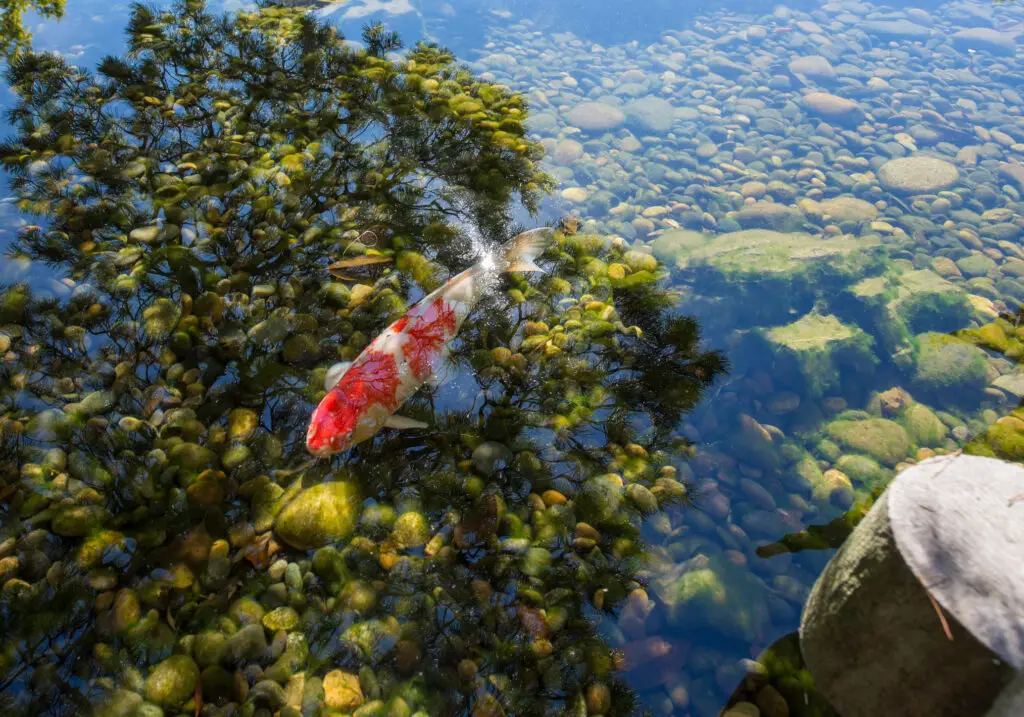
Sticking to a regular maintenance regime for your Koi Pond will keep your Koi Fish healthy and thriving. The amount of cleaning a pond requires differs from pond to pond and depends entirely on what elements are present in each pond.
Prevent large amounts of sludge forming at the bottom of your Koi Pond by ensuring you have adequate filtration, limit the number of Koi Fish in your pond, regularly add good bacteria, ensure that the water is optimally oxygenated, prune aquatic plants, and cover your pond with a leaf net.
We would all like to avoid doing arduous amounts of manual labor, draining the Koi Pond so that you can scrub the pond bottom clean of layers of sludge. The great news is that there are many things you can do to keep your Koi Pond cleaner for longer.
Pro Tip: If you’re tired of wasting money and making costly mistakes on the koi-keeping hobby or are thinking about buying koi fish but don’t know where to start, I strongly suggest you check out this ebook. I recently read this ebook, and it contains SO much useful information, such as:
- 3 proven steps to identify koi fish diseases
- WARNING: 3 things you should NEVER do when it comes to caring for koi
- When to seek professional help when it comes to looking after your koi
Causes Of Sludge Buildup At The Bottom Of A Koi Pond?
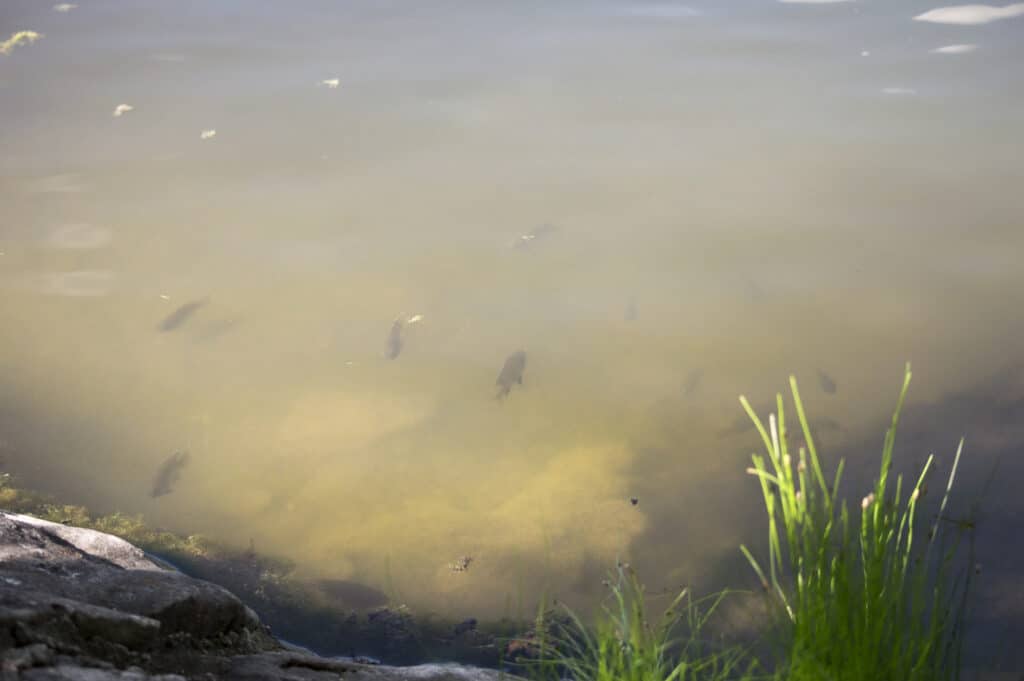
So, what exactly does sludge consist of? Well, sludge is a buildup of organic waste from fish excrement, decaying leaves, algae, and bits of uneaten fish food. In addition, inorganic materials such as silt and sand contribute to a sludgy pond bottom.
Unfortunately, this sludge’s buildup is unavoidable, and you can expect to have a thin layer of it at the bottom of your pond. Small amounts of sludge are not harmful and shouldn’t cause concern.
However, once your pond develops thick layers of sludge, it can get dangerous for your Koi Fish and indicates that your Pond ecosystem is unbalanced. You will notice a bad smell once the sludge buildup has reached a critical point.
The thicker the sludge becomes, the more difficult it is for oxygen to penetrate it. The thickened sludge will then enter an anaerobic state, affecting the pond’s bacteria and causing them to produce Hydrogen Sulphide.
The smell of rotten eggs when you disturb the bottom of your pond, will be a clear sign that your sludge situation has gotten out of hand. Hydrogen Sulphide causes havoc to your Pond ecosystem as it is toxic and will start to affect the plant life and the well-being of your Koi.
The Hydrogen Sulphide produced by the toxic sludge will kill off the good aerobic bacteria responsible for breaking down organic materials. This process will contribute to increasing sludge as the water cannot self-cleanse.
Algae will grow unchecked as the levels of anaerobic bacteria drop. During the day, algae will produce oxygen, but that process is reversed at night, consuming a large amount of oxygen. This dangerous drop in oxygen levels will cause stress and eventually kill your koi fish and aquatic plants.
In this way, a vicious cycle is formed where the bottom of your Koi Pond will develop even thicker layers of sludge, and the water quality becomes toxic. Never allow sludge to build up to such a point.
How Often Should You Clean The Bottom Of Your Koi Pond?
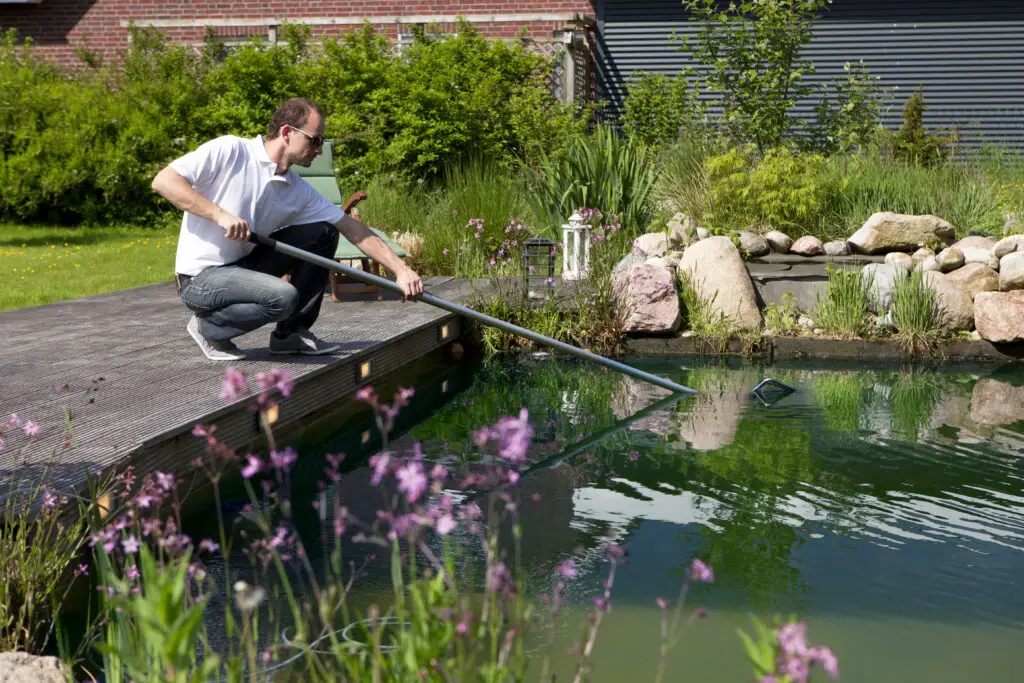
The bottom of a Koi Pond requires a thorough cleaning from time to time, but more importantly, day-to-day maintenance is required to keep it clean. Making sure that your pond has the right ecosystem to maintain the water quality and, therefore, the health of your Koi is key.
The bottom of your Koi Pond should ideally be cleaned during the Fall months as Koi Fish are at the end of their growing season and will be more resilient to the added stress.
Koi Fish are at their weakest during the Spring months. Ideally, you should try to avoid adding any unnecessary stress at this time. It would be best if you planned for a complete cleanout of your Koi Pond once a year.
If you need to clean your Koi Pond more than 4 to 5 times a year, you should take measures to improve the ecosystem of your pond.
Ecosystems That Keep The Bottom Of Your Koi Pond Clean
To keep your Koi Pond cleaner for longer, get your ecosystem in your pond to function at its optimal level. Firstly, make sure that you don’t overcrowd your pond with Koi.
Overcrowding Your Koi Pond
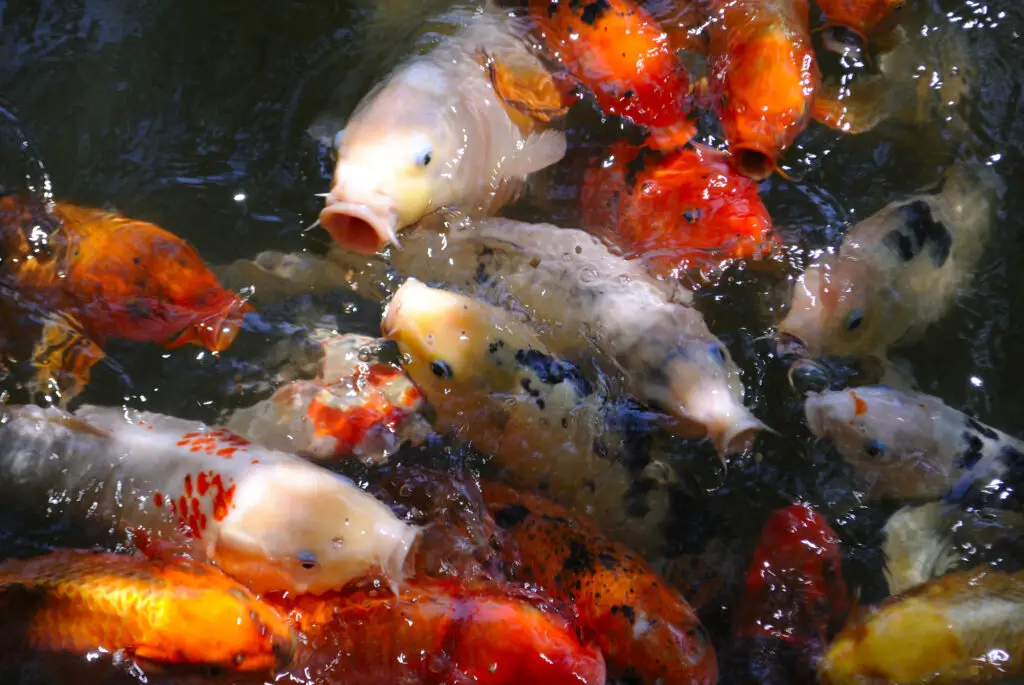
The amount of fish poop at the bottom of your pond will accumulate faster than the good bacteria in your pond can break it down, leading to stress and an unhealthy environment for your Koi.
You can calculate what pond capacity is needed by using this simple calculation: one Koi for every 250 gallons of water in your pond. This ensures that your Koi can have enough space and oxygen to grow and stay healthy.
A big contributor to pond sludge is uneaten Koi fish food that sinks to the bottom and starts to decay. No one wants to have hungry Koi Fish, but owners often underestimate the amount of food Koi Fish require.
You only have to feed your Koi once every day. Any food they don’t eat immediately will be wasted, as they won’t eat leftover food later on. Observe your Fish and note how much they eat in one feeding session; stop feeding them once they stop eating.
Adding Enough Aquatic Plants To Your Koi Pond
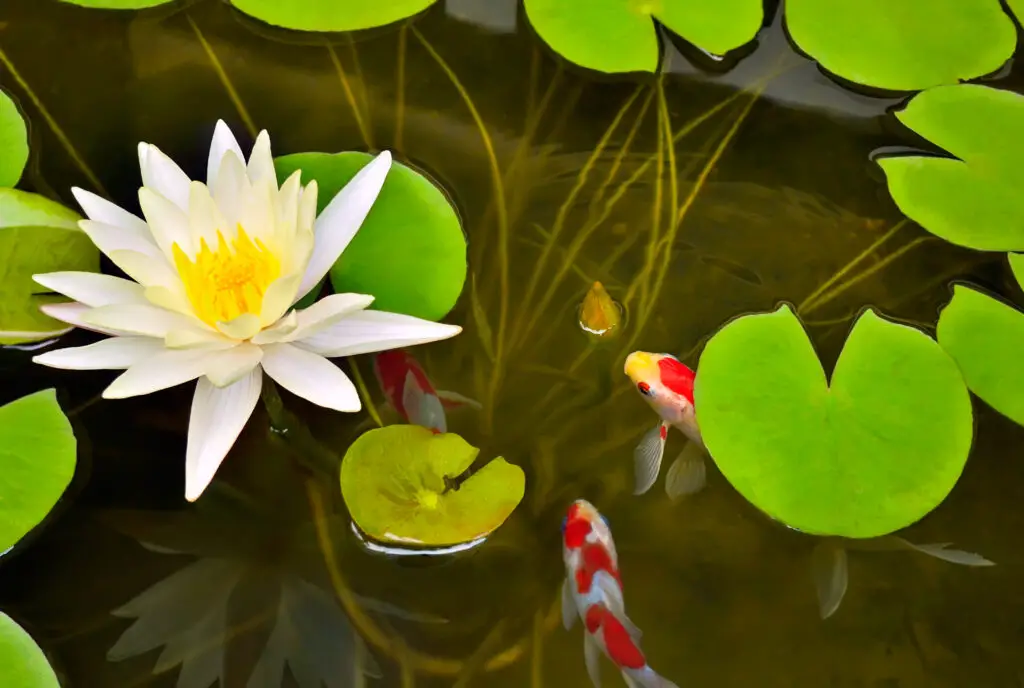
Aquatic plants can be used to balance the ecosystem in your pond and contribute to cleaning up waste and providing enough oxygen and good bacteria. Ensure that roughly 40 to 60 percent of your pond is covered with plant life.
Aim for various plants such as water lilies, water hyacinths, Lotus plants, Water Iris and Fanwort. Choose plants that are both submerged below the water’s surface and floating on top of the surface.
Decorate the edge of the pond with shallow-water marsh plants. Together, all these aquatic plants provide an effective defense against sludge buildup and make your pond look nicer as a bonus.
These aquatic plants are very helpful when temperatures soar during the summer months. They provide shaded areas for your Fish to avoid the baking sun and make sure that the balance of oxygen is kept in check, making sure that debris still gets broken down at a decent rate.
Adding A Pump To Your Koi Pond
Stagnant water tends to get dirty more quickly. Properly circulating water in your pond will ensure that enough oxygen is distributed and helps keep it clean. You will need the entire volume of your water to be circulated at least once per hour.
A pond with no natural aerators like aquatic plants or artificial aerators like pumps and filters will struggle once the water temperature reaches 75 degrees Fahrenheit or above. At this point, oxygen levels will drop to problematic levels, which are not good for your Fish!
You must install the correct pump for the size of your Koi Pond. Do regular check-ups to ensure that there are no blockages in your pump.
Pond Nets Help Keep Koi Ponds Cleaner
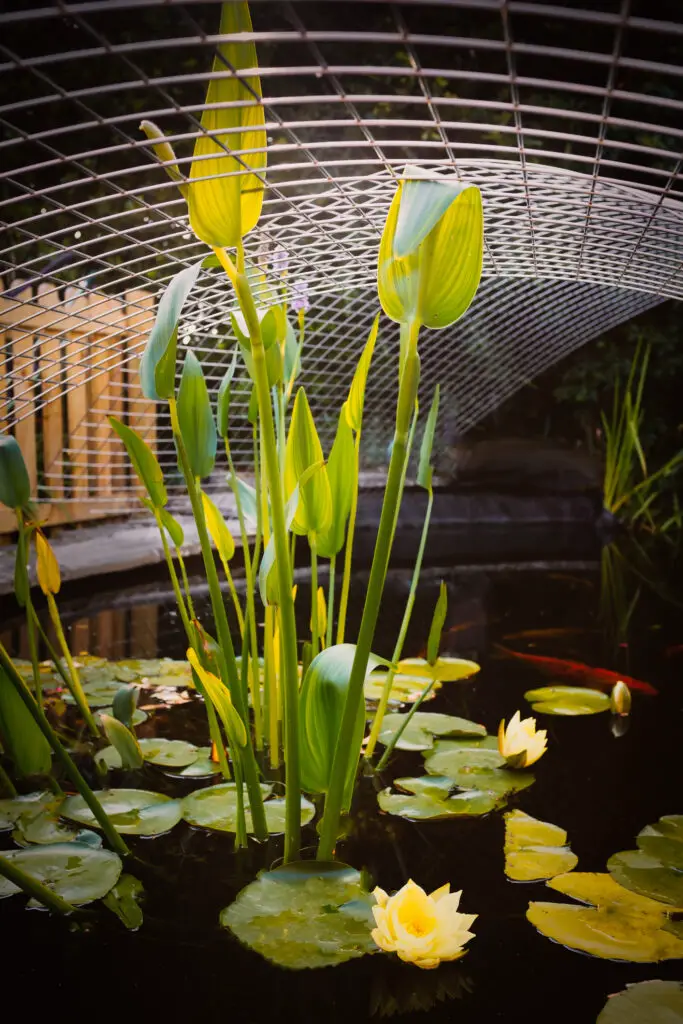
Install a Pond net over your pond to catch any dead leaves and debris that may settle at the bottom of the pond. A Pond net may be particularly helpful in the Fall months when dead leaves will inevitably land in the water.
If you opt out of installing a pond net, you can use a skimmer regularly to remove any floating leaves and debris from the pond. A skimmer is useful as you can remove a fair amount of floating and submerged objects that may fall in your pond.
You will want to clear out the net regularly to avoid debris starting to decay on top of the water. The bottom of your pond will collect more sand in windy weather, so it will help if you try to plant grass or paving if you have sandy patches in your garden.
Add A Filter To Your Koi Pond
Make sure you select the correct filter for your Koi Pond. Filters will generally state the volume of water they will filter; however, a Koi Pond will need a filter system that can cope with two to four times the volume of your Pond.
You should select a filter with a bigger capacity because your Koi Fish can produce quite a bit of organic waste. So, for instance, if you have a 1000-gallon pond, select a filter that can filter between 2000 -4000 gallons of water.
A quality water filter will work wonders in keeping your Koi Pond clean. Filters have two equally important stages: Filtering biological waste and mechanically filtering organic waste.
The biological stage of the filter system will take care of unwanted biological waste, such as Ammonia, breaking it down into smaller components that aquatic plants can easily absorb.
In the biological filter stage, media substrates are used to encourage the growth of beneficial bacteria, which then help break down organic waste.
Look for filters with UV light that will annihilate organisms like parasites and bacteria that can cause harm to your Koi Fish. Make sure that you select a slow enough flow rate for your filter, as a UV light will need enough time to cleanse the water as it passes through.
The mechanical stage of the filtration system gets rid of the larger debris and fish waste that accumulates in your pond. It will sieve out any large particles and prevent them from settling at the bottom of the pond and decaying.
Testing The Water Quality Of Your Koi Pond

The water quality of your pond is directly linked to how clean your pond is. Healthy, good-quality water is clean water, and cleaner water means less sludge buildup at the bottom of your Koi Pond.
You can anticipate the needs of your Koi Fish by checking the water regularly instead of only becoming aware of a problem once your Fish starts to suffer. You need to invest in four testing kits to test pH levels, Ammonia levels, Nitrate, and Nitrite levels.
Ammonia Levels In Your Koi Pond

The ammonia levels in your Koi Pond indicate how much organic matter such as decayed fish food and Koi Fish poo, has been dissolved in the water.
This test is useful because you can get a good idea of when to change the water in your pond. Depending on how high the Ammonia levels get, you may want to replace up to 50 percent of the water in your pond.
The ideal Ammonia level for your Koi Pond is zero. It may be difficult to maintain this reading because Ammonia is a byproduct of the breakdown of waste. Therefore, you can expect Ammonia to be present in the water. Your aim should be to keep the levels as close to zero as possible.
If your Ammonia levels read 0.25 ppm or more, you need to take some action to reduce them. One way to reduce Ammonia is by reducing the amount of food you feed your Koi for a few days.
Adding store-bought biological boosters such as Pristine Pond Cleaner and Clarifier with Highly Concentrated Beneficial Bacteria will aid the good bacteria in your pond, clean up organic waste, and reduce the amount of Ammonia being produced.
Nitrate Levels In Your Koi Pond
Once the bacteria in the pond starts to break down Ammonia, it produces Nitrates. The presence of Nitrate in your Pond water is particularly concerning because it is easily absorbed via your Koi’s gills and enters the bloodstream of your precious Fish.
The presence of Nitrates in your Koi’s bloodstream will affect the ability of Hemoglobin to carry oxygen to all the organs. The lack of oxygen supply will put your Koi in distress, exposing them to diseases and bacterial and fungal infections.
Always aim to keep the Nitrate levels in your pond as close to zero as possible. It’s advised that you check the Nitrate levels in your pond weekly if you have a new Pond that is still settling in.
Algae feed off Nitrates, and if your levels are too high, the chances are that Algae will also start to flourish.
Nitrate Levels In Your Koi Pond
The presence of Nitrate is not as lethal for your Koi as Ammonia and Nitrate, but be careful to keep levels low. An acceptable level would be lower than 0.00529 Ounces- 0.007 ounces of Nitrate per 33.81 fl. Oz.
Checking The pH levels In Your Pond
The pH level of your Koi Pond water should range between 7.2 and 8.5. The lower the reading, the more acidic your pond is, so readings below 7.2 are cause for alarm. Adding Bicarbonate of Soda or crushed coral to the pond can make it less acidic.
A Koi Pond with a cement bottom may cause high alkalinity in the Pond water, which would give you a very high pH level of above 8.5. If your water is consistently high, try changing the water or adding peat moss to reduce the alkaline level.
Conclusion
The number of times you will need to scrub the bottom of your pond can be reduced by
avoiding overcrowding, testing the water quality, and adding aquatic plants, filters, and pumps which will all aid in preventing the buildup of sludge at the bottom of your Koi Pond.
The accumulative effect of keeping the water in your Koi Pond clean and healthy will, in turn, keep the bottom of your Koi Pond cleaner for longer. You won’t need to change the water in the pond as regularly.
References
https://www.gardeningknowhow.com/ornamental/water-plants/wgen/cleaning-garden-ponds.htm
https://www.nrdc.org/stories/freshwater-harmful-algal-blooms-101


